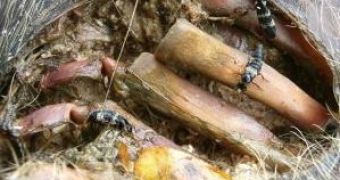Over 90 % of the species on Earth are thought to be insects, inhabiting all terrestrial habitats and eating everything. Including human corpses. That's why we can talk about forensic entomology, using insects in court cases of murder.
A team at the Forensic Entomology Service in the Department of Zoology and Animal Cell Biology at the University of the Basque Country (UPV-EHU) has started making a census of all insect species of forensic interest.
By now, police uses just necrophagous (corpse eating) flies. They detect a dead body in just a few minutes even if it is several kilometers away. Females lay eggs on the cadaver and in a few hours the larvae are born and the new individuals start to develop, feeding off the death tissues. Once fully grown, they metamorphose to adults that fly away, so that when a crime is investigated, there can be no signs of the flies. In this case, other insects could help.
The UPV-EHU team is working on detecting the colonizers of cadavers and their life cycles.
The first task is trapping baited necrophagous insects. The researchers locate animal visceras, which smell strongly and lure many insects.
Necrophagous beetle females are the most difficult to identify. Males have clearer traits, so the larvae from the females are allowed to develop and the male individuals that result are the most reliable on assessing the species. The females lay eggs on a culture medium imitating food and moisture under similar conditions similar to that of a corpse and a daily growth graph is made, at various temperature conditions, so that the growth pattern can tell in which season the victim died.
The team has undertaken sampling in the Leioa campus and in Bilbao and has detected till now differences between insects that live in urban areas and those in natural zones, a significant piece of information, telling if the crime is committed in one site and the body is subsequently moved to another.

 14 DAY TRIAL //
14 DAY TRIAL //